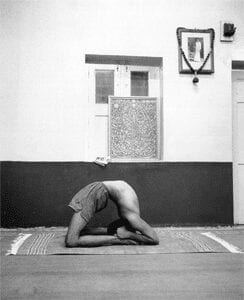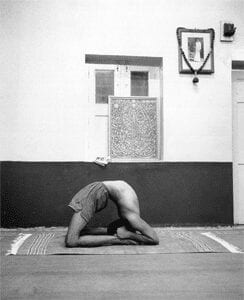
Yoga Sutra II.46 states “Sthirasukhamasanam”, meaning an asana must have dual qualities of alertness and relaxation to be considered an asana at all, let alone an effective one.
This is a principle to be practiced in any tradition of Hatha Yoga. In order to engage in poses and receive their complete benefit we must be alert but not tense, and relaxed without being dull or heavy. In my practice and teaching of Ashtanga Yoga I find this to be crucial. Unfortunately, it seems this unforgettable part of all asana practices is being forgotten in Ashtanga’s beloved lineage, by both practitioners and teachers alike.
I live in Long Island, New York, and recently many students and colleagues of mine have given up Ashtanga Yoga for more “gentle” traditions. When I ask what has brought about the change the response is often, “Ashtanga is too hard on my body” or “I don’t have the energy”. While I don’t deny that Ashtanga Vinyasa Yoga can be a challenge, isn’t it our own responsibility to find a peaceful place within that challenge? Sure, our teachers can lead us and guide us with their own knowledge but they do not inhabit our bodies and minds. It is OUR duty to be conscious during practice and know when to respect our limitations. If you aren’t ok setting limits for yourself it is high time for an ego check! If we are experiencing physical pain from our practice then what is most likely the case: The practice is to blame for hurting our bodies……or WE are approaching our practice with a forceful, all or nothing mindset?
If we abandon Ashtanga Yoga (or any method for that matter) because it isn’t giving us what we want is it really fair to blame the yoga? Isn’t yoga just a mirror to show us what is deep within us anyway? Furthermore, how can we learn Sthirasukhamasanam slowly and patiently if we just stop doing the things we need to make peace with? One of the most beautiful pieces of the Ashtanga method is that it encourages self study. Practicing with sthira and sukham requires us to constantly see ourselves objectively and to adapt to what is needed in the present moment. If we are truly present without ego we can make any asana a place of steadiness and peace.


Good post. Nice pose. Useful information has been given. The post seems to be very informative one. Thanks for sharing this useful information. By visiting this site i got more information about the Sthirasukhamasanam. I used to get more information about the yoga and its benefits from the yogasuppliesonline they are dedicators to yoga.